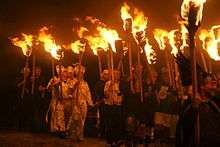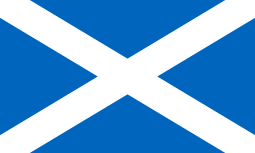Up Helly Aa
Up Helly Aa (/ˌʌp hɛli ˈɑː/ UP-hel-ee-AH;[1][2] literally "Up Holy [Day] All") can refer to any of twelve fire festivals held annually from January to March in Shetland, Scotland, to mark the end of the yule season. Each festival involves a torchlit procession by squads of costumed participants (known as guizers) that culminates in the burning of Viking galley. The main festival held in Lerwick, Shetland's capital, involves a procession of up to a thousand guizers who march through the streets of Lerwick on the last Tuesday in January.[3] The other rural festivals (known as the 'country' Up Helly Aas)[4] see lower numbers of participants in accordance with their lower populations.

| Part of a series on the |
| Culture of Scotland |
|---|
 |
| History |
| People |
|
Traditions
|
|
Mythology and folklore
|
| Cuisine |
|
| Religion |
| Art |
| Literature |
|
Music and performing arts
|
|
|
Monuments |
|
Since its inception, women and girls have been excluded from participating as guizers in the Lerwick festival. This has become a controversial issue and is the subject of ongoing debate in Shetland.[5]
Origins
The current Lerwick celebration grew out of the older yule tradition of tar barrelling which took place at Christmas and New Year as well as Up Helly Aa. Squads of young men would drag barrels of burning tar through town on sledges, making mischief.[6] Concern over public safety and levels of drunkenness led to a change in the celebrations, and saw them drawing inspiration from the islands' Viking history.[7] After the abolition of tar barrelling around 1874–1880, permission was eventually obtained for torch processions. The first yule torch procession took place in 1876. The first torch celebration on Up Helly Aa Day took place in 1881. The following year the torchlit procession was significantly enhanced and institutionalised through a request by a Lerwick civic body to hold another Up Helly Aa torch procession for the visit of Alfred, Duke of Edinburgh.[8][9] The first galley was introduced and burned in 1889.[10] The honorary role of the 'Jarl' was introduced to the festival in the early twentieth century.[11] In reality, despite many sources claiming these ancient origins, the festival, and many like it, were products of Victorian do-goodery. The Lerwick Up-Helly Aa was first established by the Total Abstinence Society in the 1870s to give the young men who would otherwise drink themselves silly something to do. The name itself derives from Upholiday, the lowland Scots' word for Twelfth Day, and was brought by them to the Shetland Islands in the 19th century.[12]
The modern event
There is a main guizer who is dubbed the "Jarl" (pron. "yarl"). There is a committee which a person must be part of for 15 years before one can be a jarl, and only one person is elected to this committee each year. The procession culminates in the torches being thrown into a replica Viking longship or galley. The event happens all over Shetland and is currently celebrated at eleven locations – Scalloway, Lerwick, Nesting and Girlsta, Uyeasound, Northmavine, Bressay, Cullivoe, Norwick, Waas, the South Mainland and Delting.[13] After the procession, the squads visit local halls (including schools, sports facilities and hotels), where private parties are held. At each hall, each squad performs its act, which may be a send-up of a popular TV show or film, a skit on local events, or singing or dancing.
Meaning
According to John Jamieson's Etymological Dictionary of the Scottish Language (1818),[14] up is used in the sense of something being at an end, and derives from the Old Norse word uppi which is still used in Faroese and Icelandic, while helly refers to a holy day or festival. The Scottish National Dictionary defines helly, probably derived from the Old Norse helgr (helgi in the dative and accusative case, meaning a holiday or festival), as "[a] series of festive days, esp. the period in which Christmas festivities are held from 25th Dec. to 5th Jan.",[15] while aa may represent a', meaning "all".[16]
Lerwick Up Helly Aa gallery
30Jan1973.jpg) 1 – The Guizer Jarl. The Guizer Jarl is the principal character in the celebration of Up Helly Aa, which takes place on the last Tuesday in January. Each Guizer Jarl takes the name of a figure in Norse legend. This one was Flokki of the Ravens.
1 – The Guizer Jarl. The Guizer Jarl is the principal character in the celebration of Up Helly Aa, which takes place on the last Tuesday in January. Each Guizer Jarl takes the name of a figure in Norse legend. This one was Flokki of the Ravens.30Jan1973.jpg) 2 – The Jarl Squad. The Jarl's Squad is made up of the Guizer Jarl's supporters. It is the principal of many squads, and the participants are called guizers.
2 – The Jarl Squad. The Jarl's Squad is made up of the Guizer Jarl's supporters. It is the principal of many squads, and the participants are called guizers.30Jan1973.jpg) 3 – The Galley. Each year a replica of a Viking longship is built for Up Helly Aa.
3 – The Galley. Each year a replica of a Viking longship is built for Up Helly Aa.30Jan1973.jpg) 4 – The Procession. After nightfall the longship is dragged through the streets of the town in a torchlight procession. The torchbearers are the members of all the squads, led by the Jarl's Squad. Each squad chooses a theme and dresses accordingly. The themes are very varied, some historical, some topical or satirical.
4 – The Procession. After nightfall the longship is dragged through the streets of the town in a torchlight procession. The torchbearers are the members of all the squads, led by the Jarl's Squad. Each squad chooses a theme and dresses accordingly. The themes are very varied, some historical, some topical or satirical.30Jan1973.jpg) 5 – The Circle Round the Galley. When all the torchbearers arrive at the final resting spot of the longship, they form a circle round it and sing the traditional Up Helly Aa song.
5 – The Circle Round the Galley. When all the torchbearers arrive at the final resting spot of the longship, they form a circle round it and sing the traditional Up Helly Aa song.30Jan1973.jpg) 6 – Setting Fire to the Galley. After the singing of the Up Helly Aa song, the guizers throw their torches into the longship.
6 – Setting Fire to the Galley. After the singing of the Up Helly Aa song, the guizers throw their torches into the longship.30Jan1973.jpg) 7 – The Burning Galley. Once the longship has burned and the flames die down, guizers sing the traditional song "The Norseman's Home" before going on to a night of partying. Any available large room is pressed into service as a hall, presided over by a hostess who issues invitations to attend, and every guizer squad visits every hall in turn to dance and drink with the guests. As there can be dozens of squads and dozens of halls, this takes most of the night and well into the following morning. The day after is the "Hop Night" where further dances and celebrations are held.
7 – The Burning Galley. Once the longship has burned and the flames die down, guizers sing the traditional song "The Norseman's Home" before going on to a night of partying. Any available large room is pressed into service as a hall, presided over by a hostess who issues invitations to attend, and every guizer squad visits every hall in turn to dance and drink with the guests. As there can be dozens of squads and dozens of halls, this takes most of the night and well into the following morning. The day after is the "Hop Night" where further dances and celebrations are held.
See also
- Burning the clavie
- Olavsfestival
- Ólavsøka
References
- "Up-Helly-Aa". Lexico UK Dictionary. Oxford University Press. Retrieved 7 October 2019.
- "Up-Helly-Aa". Collins English Dictionary. HarperCollins Publishers. Retrieved 7 October 2019.
- "Up Helly Aa". Up Helly Aa official website. Up Helly Aa Committee. Retrieved 1 August 2019.
- "Lerwick Up Helly Aa". Shetland.org. Retrieved 2020-02-24.
- "The strange island tradition firing up a gender row". bbc.com. 22 March 2019. Retrieved 25 March 2019.
- Oliver, Neil (2012). Vikings: A History. London: Weidenfeld & Nicolson. p. 9. ISBN 978-1-7802-2282-0.
- Davies, Owen (2011). Paganism : a very short introduction. New York: Oxford University Press. p. 95. ISBN 9780199235162. OCLC 731984995.
- Callum G. Brown, Up-helly-aa: Custom, Culture, and Community in Shetland (Manchester: Manchester University Press, 1998), ISBN 1901341070, pp. 126-139.
- "It cost £4,940 15/6d to build, now monument to civic splendour is 125". The Shetland Times. 2008-07-25. Retrieved 2008-12-26.
- "The Galley". Up Helly Aa. NB Communication. Retrieved 29 January 2014.
- Oliver, Neil. Vikings: A History. p. 9.
- Ronald Hutton, The Stations of the Sun: A History of the Ritual Year in Britain (Oxford: Oxford University Press, 2001), p. 43 ff.
- "Fire Festival Events". Shetland.org. Retrieved 2020-02-24.
- Jamieson, John (1818), "upp-helli-a'", An Etymological Dictionary of the Scottish Language; in which the Words are Explained in their Different Senses, Authorized by the Names of the Writers by whom they are Used, or the Titles of the Works in which they Occur, and Deduced from their Originals, Edinburgh: Printed for A. Constable and Co., and A. Jameson by Abernethy & Walker, OCLC 4363471.
- William Grant, ed. (1931–1975), "helly", The Scottish National Dictionary, Designed Partly on Regional Lines and Partly on Historical Principles, and Containing All the Scottish Words Known to be in Use or to have been in Use since c. 1700, 5, Edinburgh: Scottish National Dictionary Association, OCLC 780478, 10 vols., as reproduced in Victor Skretkowicz; Susan Rennie; William A. Craigie, eds. (2004), Dictionary of the Scots Language = Dictionar o the Scots Leid, Dundee: University of Dundee, OCLC 57069714.
- "uphalie-", Scottish National Dictionary, reproduced in the Dictionary of the Scots Language.